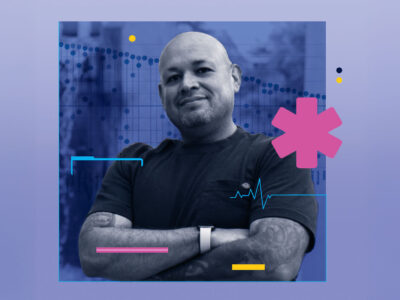Aaron Fanous’ long-held ambition to become a doctor was fueled by his father’s gastroenterology practice in Tyler, Texas. It was at this practice that he often witnessed the profound impact that medical decisions could have on people’s lives, so after completing his bachelor’s degree in chemistry at Rice University and attending medical school at UT Health San Antonio, Fanous set out to help patients make quicker, better-informed decisions through emerging technologies.
Fanous and fellow student Eri Osta made history in the spring of 2024 as the very first graduates of the nation’s first known dual degree in medicine and artificial intelligence (AI), a collaboration between the Joe R. and Teresa Lozano Long School of Medicine and University College. Launched in 2023, this groundbreaking program aims to prepare the next generation of physician leaders in healthcare through comprehensive training in applied artificial intelligence. Graduates of the program earn both a Doctor of Medicine and a Master of Science in Artificial Intelligence (MD/MSAI).
Recognizing the slower adoption of AI in healthcare due to patient privacy concerns, Fanous enrolled in the program with hopes of pioneering AI applications that would enhance patient care and streamline administrative tasks for medical professionals.
WATCH: Aaron Fanous discusses how the dual degree program prepared him to empower future physicians.
“I feel like I was in the right place at the right time in history to have been given the opportunity to enroll in the MD/MSAI program and get formal education in both fields,” Fanous says. “My mission now is to focus on problems that can be solved with AI and to help other doctors learn how AI and related technologies can benefit their practice, their patients and even their own quality of life.”
For example, AI can optimize many time-consuming administrative tasks, like appointment scheduling and summarizing patients’ charts so that doctors and their staff can spend more time on patient care. Additionally, artificial intelligence can be trained to process medical data to find certain information, such as identifying abnormalities in images generated by X-rays and MRI scans. The program’s project-based learning approach proved invaluable for Fanous, allowing him to apply what he was learning in class to solve real-world problems.
The curriculum for the MS in AI degree was developed by Dhireesha Kudithipudi, Robert F. McDermott Chair in Engineering, director of the Neuromorphic Artificial Intelligence Laboratory, and an internationally recognized scholar at the nexus of AI and human well-being. Fanous credits her for creating the foundation for the robust and meaningful learning experiences in AI that strategically complemented his medical training.
For his capstone project, Fanous aimed to expediate and improve the process of producing radiology reports. Typically, radiologists write reports summarizing the findings of X-rays, CT scans or MRIs and send them to the physician who ordered the imaging. Fanous worked with radiologist Kal Clark, MD to develop an AI model that produces radiology reports by detecting and describing what’s found in the images. He also explored ways to optimize the model so it would require less memory, making it easier for more clinicians to adopt the technology.
“Going through the MD/MSAI program was an extraordinary experience,” Fanous says. “Learning to build and develop these AI-powered systems for medical use has helped me understand what is important to both fields and will allow me to bridge the gap between technological innovation and medicine to improve lives.”
Fanous recently completed a one-year postdoctoral position at Stanford University’s Department of Biomedical Science, furthering his training and contributions to medical AI research.



No comment yet, add your voice below!